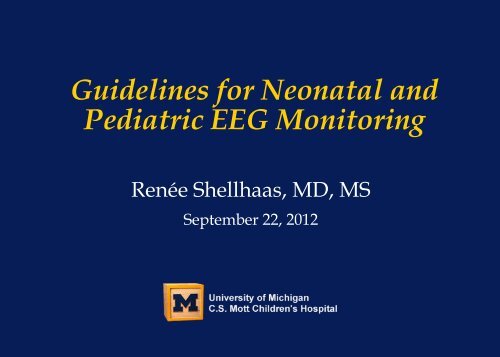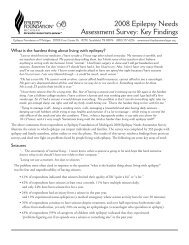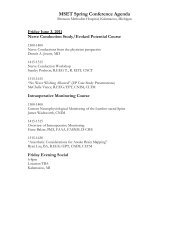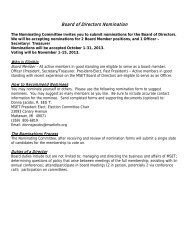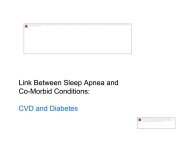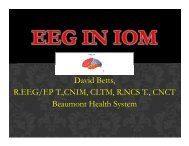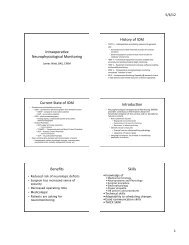Guidelines for Neonatal and Pediatric EEG Monitoring - Msetinfo.org
Guidelines for Neonatal and Pediatric EEG Monitoring - Msetinfo.org
Guidelines for Neonatal and Pediatric EEG Monitoring - Msetinfo.org
You also want an ePaper? Increase the reach of your titles
YUMPU automatically turns print PDFs into web optimized ePapers that Google loves.
<strong>Guidelines</strong> <strong>for</strong> <strong>Neonatal</strong> <strong>and</strong><br />
<strong>Pediatric</strong> <strong>EEG</strong> <strong>Monitoring</strong><br />
Renée Shellhaas, MD, MS<br />
September 22, 2012
Disclosures<br />
• No conflicts of interest?<br />
– I am a neurologist.<br />
• I read <strong>EEG</strong>s <strong>for</strong> a living.<br />
– I am not a neonatologist.<br />
• I rarely read amplitude-integrated <strong>EEG</strong>s.<br />
• I am grateful to NICHD, Child Neurology<br />
Foundation, <strong>and</strong> Janette Ferrantino Award <strong>for</strong><br />
funding my research.
Goals/Objectives<br />
• Identify indications <strong>for</strong> <strong>EEG</strong> monitoring<br />
among high-risk neonates [<strong>and</strong> children].<br />
• Discuss relative strengths <strong>and</strong> weaknesses of<br />
conventional <strong>EEG</strong> monitoring versus<br />
amplitude-integrated <strong>EEG</strong> (a<strong>EEG</strong>).<br />
• Review preferred methods <strong>for</strong> neonatal [<strong>and</strong><br />
pediatric] ICU <strong>EEG</strong> monitoring.
Caveats…<br />
• There is no evidence that <strong>EEG</strong> monitoring, seizure<br />
detection, or treatment of seizures, impacts longterm<br />
outcome.<br />
– Consensus: Dx & Rx of seizures is important.<br />
– Any <strong>EEG</strong> recording is better than none.<br />
• Delayed seizure detection is better than no recognition.<br />
– Transport (solely) <strong>for</strong> conventional <strong>EEG</strong> monitoring<br />
may be detrimental to some patients.<br />
• Not currently a st<strong>and</strong>ard of care.
<strong>Neonatal</strong> ICU <strong>Monitoring</strong>
Baylor College of Medicine<br />
• James J. Riviello, M.D.<br />
ACNS Critical Care Committee<br />
<strong>Neonatal</strong> Subcommittee Members<br />
Children’s Hospital of Philadelphia<br />
• Nicholas Abend, M.D.<br />
• Robert R. Clancy, M.D.<br />
Children’s National Medical Center<br />
• Taeun Chang, M.D.<br />
• Tammy N. Tsuchida, M.D., Ph.D.<br />
Hammersmith Hospital (London)<br />
• Courtney Wusthoff, M.D.<br />
Rainbow Babies & Children’s Hospital (Clevel<strong>and</strong>)<br />
• Mark Scher, M.D.<br />
Hospital <strong>for</strong> Sick Children (Toronto)<br />
• Cecil D. Hahn, M.D.<br />
University of Michigan<br />
• Renée A. Shellhaas, M.D., M.S.<br />
Guest Participants<br />
John Barks, M.D. (U Michigan)<br />
Hannah C. Glass, M.D. (UCSF)<br />
Terrie Inder, M.D. (Wash U)<br />
Sylvie Nguyen, M.D. (Centre Hospitalier<br />
Universitaire - Angers)<br />
Joseph E. Sullivan, M.D. (UCSF)<br />
Steven Weinstein, M.D. (Cornell)<br />
Robert White, M.D. (Memorial Hospital, IN)<br />
Shellhaas, et al. ACNS Guideline. J Clin<br />
Neurophysiol. 2011 28(6):611-617.
Indications <strong>for</strong> <strong>EEG</strong> monitoring<br />
1. High risk <strong>for</strong> seizures<br />
2. Differential diagnosis of paroxysmal events<br />
3. <strong>Monitoring</strong> during/after anticonvulsant wean<br />
4. <strong>Monitoring</strong> pharmacologically-induced burst<br />
suppression
Indications: Seizure Detection<br />
• Sick babies often have unusual movements.<br />
• Most of these are not seizures.<br />
• >50% of all neonatal seizures are subclinical.<br />
• Only detectable with <strong>EEG</strong> monitoring<br />
• Electroclinical dissociation / uncoupling:<br />
• With treatment, clinical signs may vanish while<br />
subclinical electrographic seizures continue.<br />
Clancy, et al. Epilepsia. 1988; 29:256-261.<br />
Scher, et al. <strong>Pediatric</strong>s. 1993;91:128-134.<br />
Scher, et al. <strong>Pediatric</strong> Neurol. 2003;28:277-280.
Seizures <strong>and</strong> Prognosis<br />
• Babies with neonatal seizures are at high risk<br />
<strong>for</strong> death or neurologic morbidity.<br />
– Mortality: 25-40% (may be higher in preterm)<br />
– Developmental delay: 67% @ 2-3 yrs<br />
– Cerebral palsy: 63% @ 2-3 yrs<br />
– Post-neonatal epilepsy: 17-56%<br />
McBride, Neurology 2000;55:506-514.<br />
Mizrahi, Epilepsia 2001;42(S7):102.<br />
Legido, <strong>Pediatric</strong>s 1991; 88:583-596.<br />
Scher, Pediatr Neurol 1989; 5:17-24<br />
Scher, <strong>Pediatric</strong>s 1993; 91:128-134.
Clinical vs. electrographic seizures<br />
• Video-<strong>EEG</strong> monitoring of high-risk infants.<br />
– 9% of electrographic seizures (48/526) had<br />
clinical signs recognized <strong>and</strong> documented by<br />
NICU staff.<br />
– 27% of seizures which did have clinical signs<br />
(48/179) were recognized <strong>and</strong> recorded.<br />
– 73% of “seizures” documented by NICU staff<br />
had no electrographic correlate (129/177).<br />
Murray, et al. Arch Dis Child Fetal <strong>Neonatal</strong> Ed. 2008;93:F187-F191.
The literature…read the fine print<br />
• Many studies talk about “seizures” but don’t tell us<br />
if they are clinical or electrographic (a<strong>EEG</strong> or<br />
c<strong>EEG</strong>).<br />
– Older studies usually mean clinical seizures…less<br />
applicable now that we know most seizures are<br />
subclinical.<br />
– When I say “seizure”, I mean <strong>EEG</strong> seizure.
BIRDs <strong>and</strong> Seizures<br />
• BIRD = Brief Intermittent Rhythmic Discharge<br />
–
BIRD
SEIZURE
High risk <strong>for</strong> seizures<br />
High risk of<br />
acute brain<br />
injury<br />
Prolonged<br />
circulatory arrest<br />
Hypoxic-ischemic<br />
encephalopathy<br />
Infants with<br />
sustained hypoxia<br />
Eye blinking, gazedeviation<br />
Pharmacologicallyinduced<br />
paralysis<br />
Head trauma with<br />
altered mental<br />
status<br />
Demonstrated<br />
acute acquired<br />
brain injury<br />
Arterial ischemic<br />
stroke<br />
Cerebral<br />
sinovenous<br />
thrombosis<br />
Intracranial<br />
hemorrhage<br />
Encephalitis<br />
Cerebral edema<br />
due to inborn errors<br />
of metabolism<br />
Clinically<br />
suspected<br />
seizures<br />
Focal clonic or tonic<br />
movements<br />
Unexplained apnea<br />
Myoclonus<br />
Bicycling
High risk <strong>for</strong> seizures<br />
High risk of<br />
acute brain<br />
injury<br />
Prolonged<br />
circulatory arrest<br />
Hypoxic-ischemic<br />
encephalopathy<br />
Infants with<br />
sustained hypoxia<br />
Eye blinking, gazedeviation<br />
Pharmacologicallyinduced<br />
paralysis<br />
Head trauma with<br />
altered mental<br />
status<br />
Demonstrated<br />
acute acquired<br />
brain injury<br />
Arterial ischemic<br />
stroke<br />
Cerebral<br />
sinovenous<br />
thrombosis<br />
Intracranial<br />
hemorrhage<br />
Encephalitis<br />
Cerebral edema<br />
due to inborn errors<br />
of metabolism<br />
Clinically<br />
suspected<br />
seizures<br />
Focal clonic or tonic<br />
movements<br />
Unexplained apnea<br />
Myoclonus<br />
Bicycling
High risk <strong>for</strong> seizures<br />
High risk of<br />
acute brain<br />
injury<br />
Prolonged<br />
circulatory arrest<br />
Hypoxic-ischemic<br />
encephalopathy<br />
Infants with<br />
sustained hypoxia<br />
Eye blinking, gazedeviation<br />
Pharmacologicallyinduced<br />
paralysis<br />
Head trauma with<br />
altered mental<br />
status<br />
Demonstrated<br />
acute acquired<br />
brain injury<br />
Arterial ischemic<br />
stroke<br />
Cerebral<br />
sinovenous<br />
thrombosis<br />
Intracranial<br />
hemorrhage<br />
Encephalitis<br />
Cerebral edema<br />
due to inborn errors<br />
of metabolism<br />
Clinically<br />
suspected<br />
seizures<br />
Focal clonic or tonic<br />
movements<br />
Unexplained apnea<br />
Myoclonus<br />
Bicycling
Indications: Differential diagnosis<br />
Clinically<br />
suspected<br />
seizures<br />
Focal clonic or tonic<br />
movements<br />
Eye blinking, gazedeviation<br />
Unexplained apnea<br />
Myoclonus<br />
Bicycling<br />
Unexplained altered<br />
mental status<br />
• Most abnormal neonatal<br />
movements have no electrographic<br />
correlate.<br />
• Neonates don’t have generalized<br />
tonic-clonic seizures!<br />
• Heart rate changes during seizures<br />
are not consistent.<br />
• Isolated changes in vital signs are<br />
rarely due to seizures.
Indications: During/after<br />
anticonvulsant drugs are weaned<br />
• Depends on seizure etiology<br />
• Lissencephaly vs. HIE<br />
• How hard were the seizures to control?<br />
• How many meds are you giving?<br />
• What are your goals?
Indications: Burst suppression<br />
– Refractory status-epilepticus:<br />
• Titrate medication to optimize burst/interburst<br />
ratios.<br />
– Severe metabolic encephalopathy:<br />
• e.g. Discontinuity improves as hyperammonemia<br />
is corrected.
Indications: Prognosis<br />
• Evaluating <strong>EEG</strong> background:<br />
– Evolution of background patterns in neonatal<br />
encephalopathies<br />
• Serial routine <strong>EEG</strong>s may be sufficient.<br />
– Sufficient duration to capture both<br />
wakefulness <strong>and</strong> sleep, if such state changes<br />
exist
Background Classification<br />
• Mildly abnormal:<br />
– Mild excess discontinuity<br />
– Mild simplification of mixture of frequencies<br />
– Mild focal abnormalities (like excess sharp<br />
transients or focal voltage attenuation)<br />
• Prognosis is good!<br />
• Remember context... Ex: Babies with Down<br />
syndrome can often have normal neonatal <strong>EEG</strong> but<br />
can be expected to have abnormal developmental<br />
outcome.
Background Classification<br />
• Moderately Abnormal<br />
– Moderately excessive discontinuity<br />
– Moderately excessive asynchrony<br />
– Poverty of expected background rhythms<br />
– Definite focal abnormalities<br />
– Persistent low voltage (
Background Classification<br />
• Markedly abnormal:<br />
– Markedly excessive discontinuity (can have some<br />
preservation of age-appropriate background<br />
patterns)<br />
– Burst suppression<br />
– Gross interhemispheric asynchrony<br />
– Extreme low voltage (
<strong>Neonatal</strong> <strong>EEG</strong>: Technical Aspects<br />
• International 10-20 system<br />
– Modified <strong>for</strong> neonates*<br />
– Minimum 9 scalp electrodes<br />
• EKG<br />
• Respiratory channel<br />
• Eye leads<br />
• EMG lead<br />
*Not all laboratories utilize the Pz electrode. Alternate terminology<br />
designates “FP” electrodes as “AF”, <strong>and</strong> T 3/4 as T 7/8 .
Technical Aspects:<br />
<strong>Neonatal</strong> Montages<br />
• Combined double- <strong>and</strong> single-distance<br />
electrodes
Technical Aspects:<br />
<strong>Neonatal</strong> Montages
Technical Aspects:<br />
Event marker<br />
• Event button to be pressed <strong>for</strong>:<br />
– clinical episodes<br />
– relevant medication administration<br />
– events that could cause cerebral injury<br />
– Need the bedside observer to PTFB!!!!<br />
– When you push the button SAY OUT LOUD<br />
why you are doing so.<br />
• “Look! His left pinky finger twitched.”<br />
• “I’m giving the phenobarb bolus now.”
Technical Aspects:<br />
Bedside log<br />
• Bedside log to document the time<br />
<strong>and</strong> description of event(s).<br />
–Or direct annotation on video <strong>EEG</strong> record<br />
•Type into computer
Duration of Recording:<br />
SCREENING <strong>for</strong> Seizures<br />
• A routine <strong>EEG</strong> is inadequate to screen <strong>for</strong><br />
neonatal seizures.<br />
• Normal <strong>EEG</strong> background does not preclude seizures.<br />
• Scenarios <strong>for</strong> routine <strong>EEG</strong> exams:<br />
1. The baby is having seizures need <strong>EEG</strong> monitoring<br />
2. We didn’t capture an event need <strong>EEG</strong> monitoring<br />
3. <strong>EEG</strong> background looks terrible need <strong>EEG</strong> monitoring<br />
4. Background looks ok but baby doesn’t need <strong>EEG</strong><br />
monitoring<br />
5. See the pattern?
Duration of Recording:<br />
SCREENING <strong>for</strong> Seizures<br />
• Recommend a minimum of 24 hours.<br />
– Skip the routine <strong>EEG</strong>.<br />
– If no seizures <strong>and</strong> <strong>EEG</strong> background is stable,<br />
stop after 24 hours of monitoring.<br />
– Mean time to seizures:<br />
• <strong>Neonatal</strong> cardiac surgery: 21 hrs (range 10-36 hrs)<br />
• HIE with hypothermia: 9.5 hrs (range 5.5-98 hrs).<br />
• Heterogeneous high-risk neonates: Always ≤22 hrs.<br />
Clancy et al, Epilepsia. 2005;46:84-90.<br />
Laroia et al, Epilepsia. 1998;39:545-51.<br />
Wusthoff et al, J Child Neuro. 2011;26:724-728.
Duration of Recording:<br />
CONFIRMED Seizures<br />
• Recommend conventional <strong>EEG</strong><br />
monitoring until 24-hrs seizure-free.<br />
– Unless, in consultation with a neurologist, the<br />
decision is made to stop sooner.<br />
– Almost no data…
Duration of Recording:<br />
Differential Diagnosis of Events<br />
• Recommend continuing <strong>EEG</strong> monitoring until<br />
multiple typical events are recorded.<br />
– If 3-4 typical events are captured, <strong>and</strong> are not<br />
seizures, <strong>and</strong> the <strong>EEG</strong> background remains<br />
normal or stable, then monitoring may be<br />
discontinued.
<strong>EEG</strong> Interpretation & Reporting<br />
• Interpretation by technologists / nurses:<br />
– Tech to remain at bedside <strong>for</strong> 1 st 1-hr epoch<br />
– Tech <strong>and</strong> nurses to periodically assess <strong>EEG</strong> quality<br />
• Interpretation by clinical neurophysiologist:<br />
– First hour of <strong>EEG</strong> should be interpreted ASAP.<br />
– <strong>EEG</strong> should be reviewed at least twice per 24-hour epoch.<br />
• Reporting results:<br />
– At least daily<br />
– Verbal <strong>and</strong> written communication are required.<br />
– This recommendation applies to both conventional AND reduced<br />
montage <strong>EEG</strong>.
What about a<strong>EEG</strong>?
Amplitude-Integrated <strong>EEG</strong> (a<strong>EEG</strong>)<br />
• Single channel from biparietal<br />
electrodes.<br />
• over watershed zone<br />
• many now use 2 a<strong>EEG</strong> channels<br />
plus “raw” <strong>EEG</strong><br />
• Leads applied by nurse or<br />
neonatologist.<br />
• Interpreted by neonatologists.<br />
• Short- or long-term<br />
monitoring.<br />
• Easy to visually track trends.
FP1-T3<br />
T3-O1<br />
FP2-T4<br />
75 uV<br />
2 sec<br />
T4-O2<br />
St<strong>and</strong>ard<br />
neonatal <strong>EEG</strong><br />
FP1-C3<br />
C3-O1<br />
FP2-C4<br />
C4-O2<br />
T3-C3<br />
C3-CZ<br />
CZ-C4<br />
C4-T4<br />
C3-C4<br />
Single channel<br />
raw <strong>EEG</strong><br />
Filter 15Hz, rectify, smooth, amplitude-integrate<br />
Amplitude Integrated <strong>EEG</strong><br />
(a<strong>EEG</strong>)
a<strong>EEG</strong> monitoring: HIE<br />
• Predicting outcome after HIE:<br />
– Early a<strong>EEG</strong> background<br />
– Sleep-wake cycling<br />
• Hypothermia modifies a<strong>EEG</strong> background:<br />
– Normalize by 48 hours good outcome<br />
• 24 hours <strong>for</strong> normothermia<br />
– Lack of sleep-wake cycling = poor prognosis<br />
al Naqeeb. <strong>Pediatric</strong>s 1999;103:1263-71.<br />
Shalak. <strong>Pediatric</strong>s 2003;111:351-7.<br />
Toet. Arch Dis Child Fetal <strong>Neonatal</strong> Ed 1999;81:19-23.<br />
Thoresen. <strong>Pediatric</strong>s. 2010:126;e131-e139.
a<strong>EEG</strong> monitoring: preterm infants<br />
• Outcome Prediction<br />
• Excessive discontinuity (lower margin amplitude)<br />
• Lack of sleep-wake cycling<br />
• predicts adverse outcome <strong>for</strong> Grade III-IV IVH.<br />
• < 29 weeks: excess discontinuity <strong>and</strong> absence of sleepwake<br />
poor short term prognosis.<br />
• Abrupt changes in a<strong>EEG</strong> background can<br />
correlate with new pathology.<br />
Bowen. <strong>Pediatric</strong> Research. 2010; 67(5):538-44.<br />
Hellström-Westas. Neuropediatrics. 2001; 32(6):319-24.<br />
Niemarkt . Neonatology. 2010; 97(2):175-82.<br />
Olischar. Childs Nerv Syst. 2001; 20(1):41-5.
What about a<strong>EEG</strong> <strong>for</strong> seizures?
The literature…read the fine print<br />
• Distinguish between “seizure positive” a<strong>EEG</strong> or<br />
<strong>EEG</strong> records <strong>and</strong> individual seizure detection.<br />
– 8 of 10 patients correctly identified as having seizures<br />
versus 8 of 10 individual seizures correctly detected.
<strong>EEG</strong>: the Gold St<strong>and</strong>ard<br />
• Conventional <strong>Neonatal</strong><br />
<strong>EEG</strong> is the gold<br />
st<strong>and</strong>ard <strong>for</strong> the<br />
diagnosis <strong>and</strong><br />
quantification of<br />
neonatal seizures <strong>and</strong><br />
<strong>for</strong> assessment of <strong>EEG</strong><br />
background<br />
10-20 system, modified <strong>for</strong> neonates
a<strong>EEG</strong> often used to screen <strong>for</strong> seizures
Seizures on a<strong>EEG</strong><br />
• 125 routine <strong>EEG</strong>s with seizures (+19 without),<br />
recorded from 140 term newborns.<br />
• Created single-channel a<strong>EEG</strong> traces.<br />
– Interpreted by 6 neonatologists with varying expertise.<br />
% of 125 a<strong>EEG</strong> records<br />
with seizures detected<br />
Mean = 40.3% ± 16.8%<br />
(range: 22-57%)<br />
% of 851 individual<br />
seizures detected<br />
Mean = 25.5% ± 10.6%<br />
(range: 12-38%)<br />
* No false positive records; very few false positive individual seizures.<br />
Shellhaas, et al. <strong>Pediatric</strong>s. 2007;120:770-777.
Seizures on a<strong>EEG</strong><br />
• Factors related to seizure detection by a<strong>EEG</strong><br />
(multivariate analysis*):<br />
• Neonatologists’ level of experience with a<strong>EEG</strong><br />
• Visibility in C3C4 raw <strong>EEG</strong> channel<br />
• Seizure duration<br />
• Peak-to-peak amplitude<br />
• Seizure count per hour<br />
*P=
Adding “raw” <strong>EEG</strong><br />
• Simultaneously recorded single <strong>and</strong> dual<br />
channel a<strong>EEG</strong> with conventional <strong>EEG</strong> in 7<br />
neonates with seizures.<br />
– Readers: two experienced neonatologists<br />
– Using both two-channel a<strong>EEG</strong> <strong>and</strong> the raw<br />
tracings, sensitivity = 76%<br />
– Using just a<strong>EEG</strong>, sensitivity = 27%-56%<br />
– 1 false-positive per 39 hours of recording<br />
Shah, et al. <strong>Pediatric</strong>s. 2008;121:1146-1154.
Confirming a<strong>EEG</strong> findings<br />
• Brief, infrequent, low amplitude seizures are<br />
hardest to detect on a<strong>EEG</strong>.<br />
• If you see a seizure, you’re probably right.<br />
• If you don’t see seizures… doesn’t mean they aren’t<br />
there.<br />
• Don’t declare victory based on a<strong>EEG</strong>.<br />
• Suspect seizures on a<strong>EEG</strong> conventional <strong>EEG</strong>.<br />
– Confirm diagnosis<br />
– Direct treatment
Concurrent <strong>EEG</strong> <strong>and</strong> a<strong>EEG</strong>:<br />
Best of both worlds?
Summary:<br />
<strong>Neonatal</strong> <strong>EEG</strong> monitoring<br />
• <strong>Neonatal</strong> <strong>EEG</strong> (c<strong>EEG</strong> <strong>and</strong> a<strong>EEG</strong>) background<br />
assessments can assist with estimating<br />
prognosis.<br />
• <strong>EEG</strong> monitoring is the st<strong>and</strong>ard <strong>for</strong> neonatal<br />
seizure diagnosis <strong>and</strong> assessment of treatment<br />
response.<br />
• Use a<strong>EEG</strong> when don’t have <strong>EEG</strong>.<br />
• Document!
<strong>Pediatric</strong> ICU <strong>EEG</strong> monitoring
Indications <strong>for</strong> <strong>EEG</strong> monitoring<br />
1. High risk <strong>for</strong> seizures<br />
2. Differential diagnosis of paroxysmal events<br />
3. <strong>Monitoring</strong> pharmacologically-induced burst<br />
suppression
PICU <strong>Monitoring</strong>:<br />
High risk <strong>for</strong> seizures<br />
• Age < 1(or 2) year(s)<br />
• Convulsive seizure or status epilepticus<br />
– ± history of epilepsy<br />
• Acute brain injury<br />
– Focal (stroke) or diffuse (HIE)<br />
– Traumatic brain injury<br />
Other high risk clinical scenarios:<br />
• Ex: Need <strong>for</strong> pharmacologic paralysis<br />
+ prior seizures / acute brain injury
PICU <strong>Monitoring</strong>:<br />
High risk <strong>for</strong> seizures<br />
• High-risk <strong>EEG</strong> features:<br />
– Lack of reactivity<br />
– Epilepti<strong>for</strong>m abnormalities
PICU <strong>Monitoring</strong>:<br />
Differential diagnosis<br />
• Non-seizure paroxysmal events are common.<br />
– ~25% of unselected sample of ICU <strong>EEG</strong><br />
monitoring studies had non-epileptic events.<br />
Williams. Epilepsia. 2011;52:1130-1136.<br />
• Accurate identification matters<br />
– Avoid unnecessary medications (+ side effects)
PICU <strong>Monitoring</strong>:<br />
Iatrogenic Burst Suppression<br />
• Children requiring pharmacologicallyinduced<br />
burst suppression need continued<br />
<strong>EEG</strong> monitoring.<br />
– Evaluate <strong>for</strong> break-through seizures<br />
– Ensure appropriate medication titration
PICU <strong>Monitoring</strong>: Duration<br />
• 24 hours screening <strong>for</strong> non-convulsive (or<br />
subclinical) seizures:<br />
• ~95% of children with non-convulsive seizures will<br />
be detected with 24 hours of <strong>EEG</strong>.<br />
Abend. Neurology. 2011.<br />
• 100% of those with only non-convulsive seizures (no<br />
clinically-apparent seizures) detected in 24 hours .<br />
McCoy. Epilepsia. 2011.<br />
• Or until events of interest are recorded <strong>and</strong><br />
determined not to be seizures.<br />
• And <strong>EEG</strong> background stable or normal.
PICU <strong>Monitoring</strong>:<br />
Technical aspects<br />
Also EKG; others as needed.<br />
See neonatal <strong>EEG</strong> guidelines re: review, reporting...
Digital Trending<br />
• Compressed display<br />
• Highlight epochs of concern<br />
• Facilitate timely <strong>EEG</strong> review<br />
• Need more study!
Conclusions<br />
• Subclinical seizures are common among<br />
neonates <strong>and</strong> children in ICUs.<br />
– Can only be diagnosed with <strong>EEG</strong>.<br />
• <strong>EEG</strong> monitoring is gold st<strong>and</strong>ard <strong>for</strong> seizure<br />
diagnosis <strong>and</strong> quantification.<br />
– Digital trending might help.<br />
• Refer to ACNS guidelines <strong>for</strong> neonates.<br />
• Stay tuned <strong>for</strong> ACNS pediatric & adult<br />
guidelines.


